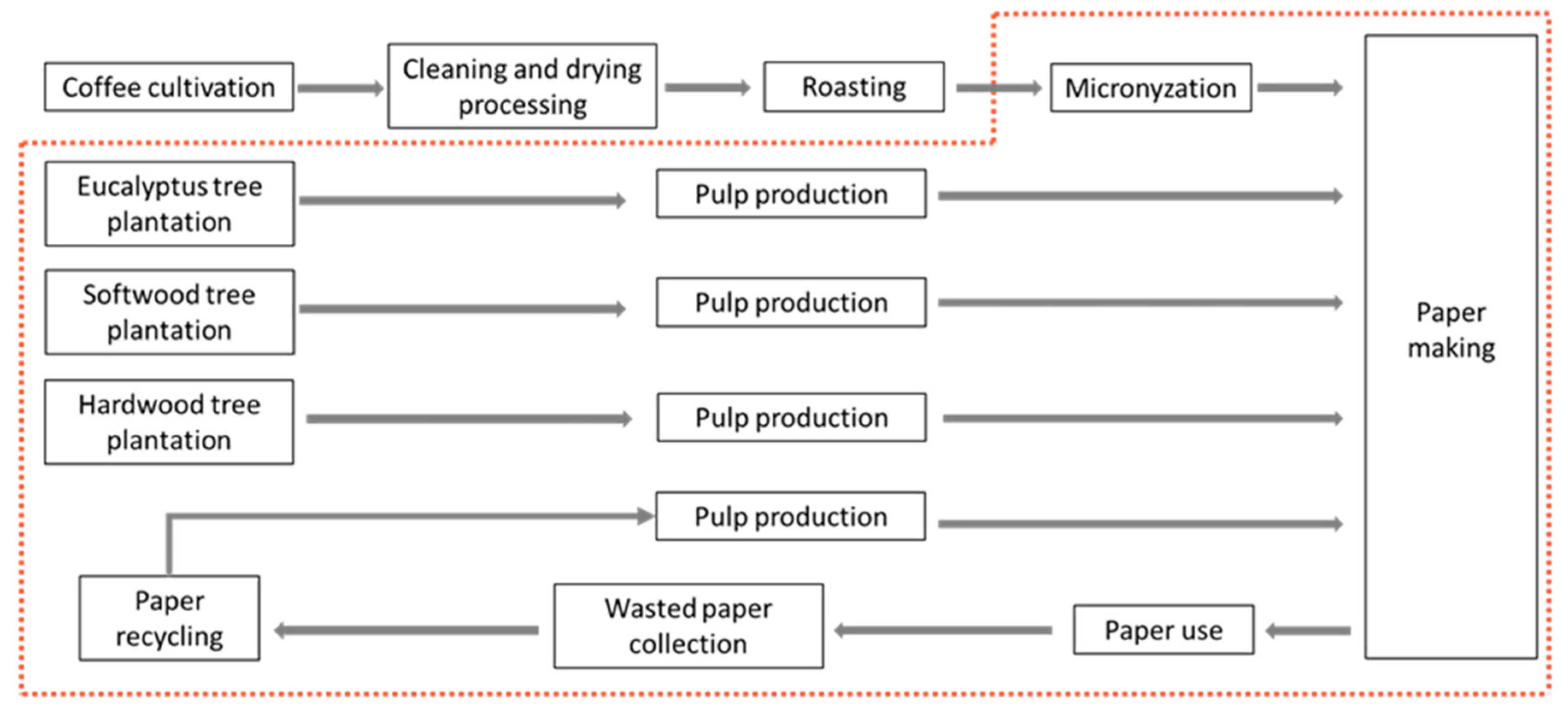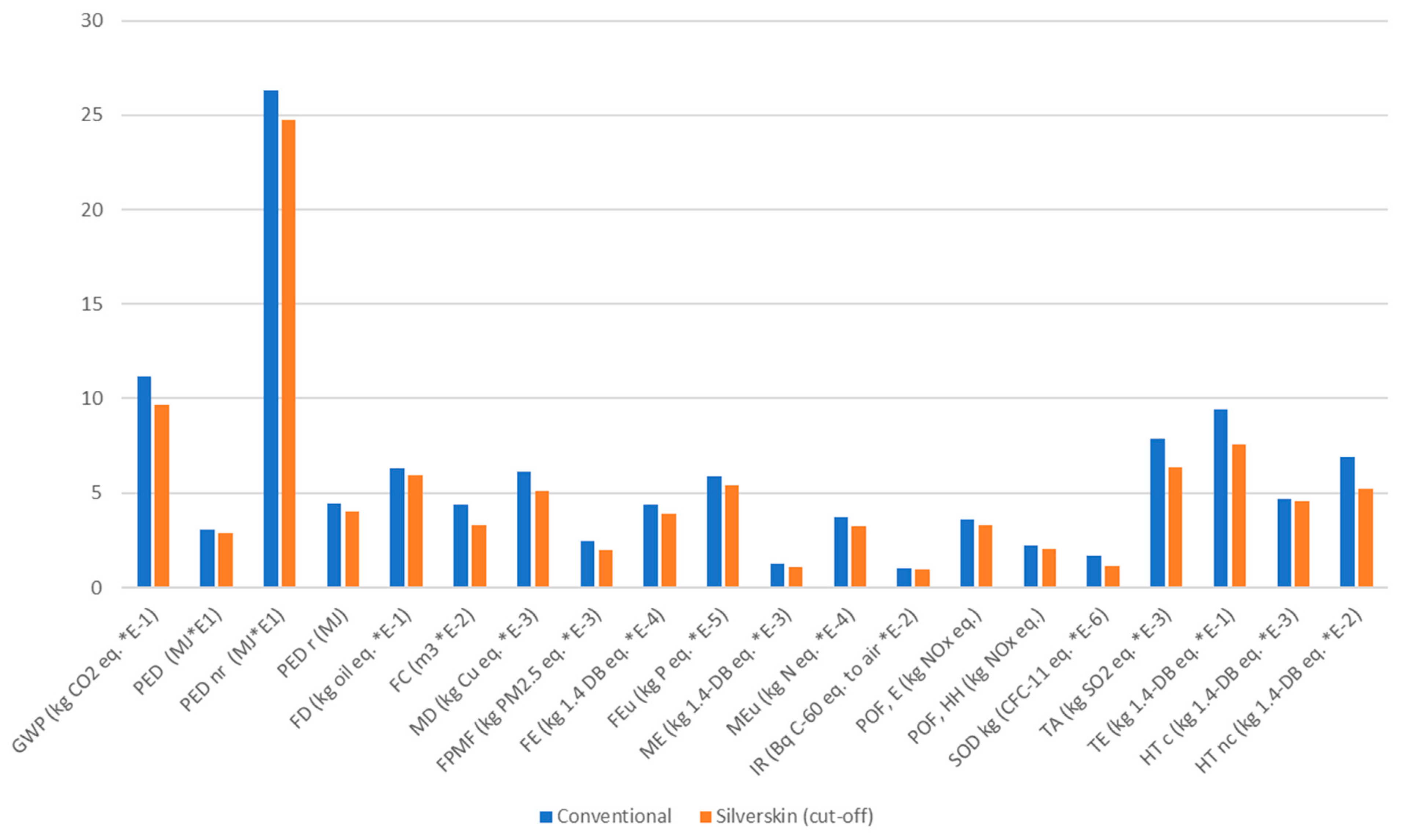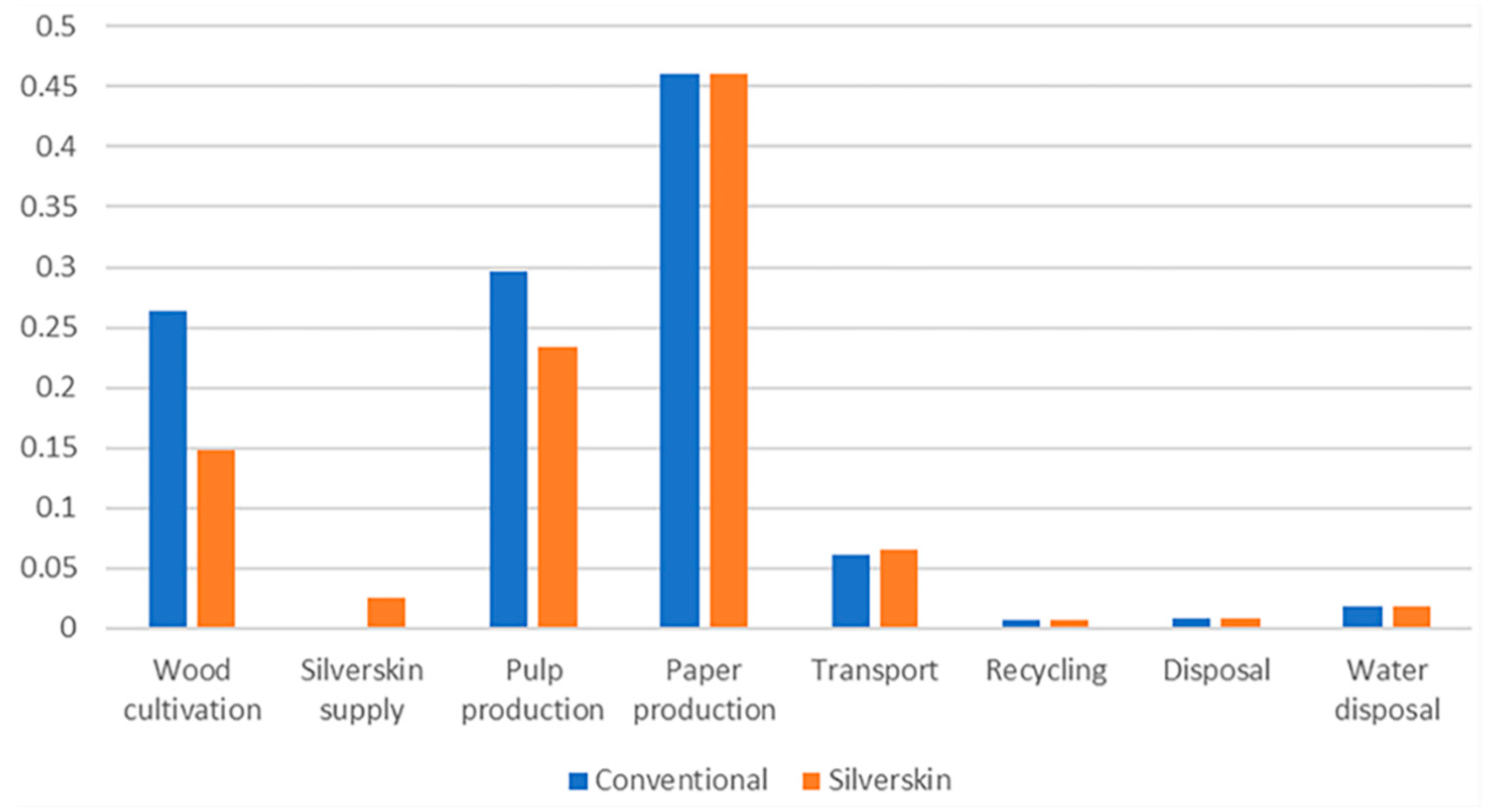1. Introduction
In 2018, the EU’s primary energy consumption accounted for approximately 1600 million tons of oil equivalent per year (Mtoe/y), of which a major contribution is provided by heating and cooling applications (around 800 Mtoe/y, which also includes industrial heat), followed by transport and electricity—which account for nearly 520 Mtoe/y and 280 Mtoe/y, respectively [
1,
2,
3,
4]. By 2030, the EU intends to further lower domestic greenhouse gas (GHG) emissions by 55% relative to 1990 levels. Moreover, EU countries have declared the goal of being the first climate neutral continent by 2050 [
5,
6]. The fulfilment of the Paris COP21 agreement is going to require equal, if not more, reduction of GHG emissions [
6].
Circular economy (CE) plays a crucial role in this scenario. Circular economy intends to recover and valorize wastes and residues (from here on referred to as byproducts), adding value to these materials which can be included back into supply chains and minimizing the waste creation along the production pathways [
7]. Moreover, the CE concept is gaining attention among researchers and institutions since it has potential to increase the sustainability of production and consumption systems [
8]. According to the European Parliament, CE could increase the gross domestic product by 0.5% and create about 700,000 new jobs in the EU by 2030 [
7]. By tapping into previously unexploited pools of byproducts, a new, valuable resource is available.
A study published by the EU in 2010 revealed that nearly 90 million tons of food byproducts are expelled from the food manufacturing industry every year [
9]. Food industry byproducts could be utilized as raw material for multiple purposes. For example, large amounts of lignocellulosic material from food processing can be converted into ethanol [
10] or biogas [
11]. Food byproducts are also a potential reservoir for high value-added chemicals [
12,
13], including lipids, nutraceuticals, other bioactive compounds, bioplastics, etc. A recent report demonstrates that production of bulk chemicals from biomass waste is 3.5 times more profitable than converting it into biofuel [
14].
Coffee is one of the world’s most popular beverages, amounting to about ten million tonnes of roasted coffee consumed annually worldwide (2018/2019). In 2015, Italy was the third-largest international green coffee importer, after the USA and Germany. Coffee is imported into Italy for roasting which, together with brewing, is the industrial process responsible for the final flavor and aroma of coffee. Different byproducts are produced along the whole coffee life cycle [
15]. In the past 10 years, spent coffee grounds have received significant attention, especially as an alternative bioenergy resource [
16]. Oil suitable for biodiesel production can be extracted from spent coffee grounds or these residues can be transformed into bricks and pellets which could be used in domestic wood burners and multi-fuel stoves [
17]. The coffee roasting process also generates a biowaste called coffee silverskin (CSS). Coffee silverskin is a very thin, papery material accounting for about 1.5% of the total mass of unroasted coffee. In Italy, approximately 7500 tonnes of CSS are produced each year due to the large coffee roasting industry [
15,
16]. Currently CSS is largely unexploited and, to the best of our knowledge, no major valorization of CSS is on the market yet.
FAVINI srl [
18], a company producing paper since 1736, developed a method called “CRUSH” which involves the use of byproducts and residues of agri-food transformations to produce paper. The vegetable residues (peels, shells, or pits) are dried at controlled temperature and milled to obtain a flour that is micronized and added to paper pulp. The amount of these flours can reach nearly 15% by weight, with significant savings of virgin cellulose [
19].
Within the multidisciplinary project “CirCo-Multi valorization of silverskin, a residue of the coffee roasting industry” (funded by The Cariplo Foundation and Innovhub Stazioni Sperimentali per l’Industria S.r.l. [
20]), the possibility to use these industrial coffee byproducts as a raw material in other industrial processes, embracing the CE concept, is examined.
Silverskin is mainly formed by cellulose together with other value-added chemicals (i.e., polyphenols, fat, and waxes) that are extremely interesting for its valorization [
21]. Due to the high content in cellulose and to the significance of reducing the import of virgin cellulose in Italy, the use of CSS in paper manufacturing was envisaged [
15]. Samples of graphic paper containing 15% of micronized CSS have been prepared in the framework of the CirCo project and its quality was found to be comparable with that of conventionally prepared paper.
However, besides the verification of the technical feasibility of using CSS as a raw material for paper production, it is fundamental to assess the sustainability of this new circular system since prolonging the lifetime of a material (i.e., byproduct) does not automatically confer sustainability. When modifications to the current industrial system occur due to the inclusion of byproducts, it is fundamental to verify their potential in reducing resource and energy consumption, greenhouse gas (GHG) emissions, and other environmental, economic, and social burdens along the whole life-cycle chain.
Life cycle assessment (LCA) and life cycle costing (LCC) analyses are powerful tools for considering the environmental and economic sustainability of a particular good. Life cycle assessment is an internationally standardized (ISO 14040/2006 [
22]; ISO 14044/2006 [
23]) methodology that allows a quantitative assessment of the environmental performance of a product, process, or system along their whole life cycle. Based on the LCA concept, the LCC method evaluates the costs occurring along the whole chain, analyzing the economic side of sustainability [
7].
The goal of this study is to verify that use of CSS as a raw material for paper production decreases energy demand and environmental costs and increases economic benefits for the Italian graphic paper sector.
The results of this work provide useful insights to entrepreneurs and to policy makers, identifying environmental and economic trade-offs which could occur along the system’s life cycle. Based on the investigation performed in the CirCo activities report [
24] and Boschiero & Pezzutto, 2019 [
8], which are characterized by a consistent input from the CirCo project form [
15], an elaborated analysis has been carried out. We explain, in detail, the context of the investigation, provide an interpretation of the main findings, and discuss its implications.
The following section,
Section 2, includes the materials and methodology that supported the study.
Section 3 specifies the primary outcomes in findings and figures.
Section 4 critically evaluates the top results, and
Section 5 indicates the conclusions with potential future implications and recommendations.
4. Discussion
Comparing the results with other studies is difficult for numerous reasons. A specific system is analyzed in each study, which may sometimes allow for reasonable comparisons when assumptions are made. Furthermore, various distinct impact assessment methods are selected, and separate impact categories are analyzed, making any comparisons even more problematic.
The figure regarding GWP that was obtained in our study is in line with the figure reported in two separate carbon-footprints carried out for FAVINI srl regarding paper made with other agricultural residues. Our results for conventional paper are in line with the figures reported in Silva et al., 2015 [
30].
The LCA results show that there is an advantage in including coffee silverskin in paper production compared to using virgin pulp alone. There is approximately 10% environmental impact reduction through the incorporation of CSS in paper production method relative to using virgin pulp alone. Moreover, we registered a 13% reduction in GHG emissions concerning the CSS paper production method compared to the conventional method.
This result should not be taken for granted. The use of agri-food byproducts as secondary raw materials is a topic of relevant interest in the Bio-economy scenario that is strongly encouraged by the EU. However, some initiatives have turned out to be less sustainable than conventional disposal, such as landfilling, after a careful LCA analysis. This was the case with the use of spent coffee grounds to produce biodiesel in the UK according to one recent study [
53].
In addition to the environmental benefits conferred by incorporating CSS into paper production, the LCC analysis indicates that the difference in cost of production is competitive and marginally lower for CSS paper versus conventional paper. The LCC results show that the divergence between the two paper production methods is quite small: we determined a 0.01% reduction using the CSS production method.
Data acquisition required a significant effort due to the unique material under study. There are data gaps in the scientific literature, especially on the topic of coffee processing and cultivation. These data, along with data regarding much of the paper production process, is only available through the private sector, making robust LCA and LCC results difficult to obtain. While the cooperation of FAVINI srl made good estimates of their processes possible, the conventional processes required many assumptions as far as transport distances: energy consumption for certain processes and sources for raw material.
As with all LCA and LCC analyses, several assumptions were needed. One of the main considerations affecting the outcome of the model is how to consider the CSS itself. Silverskin is a residue and can thus be considered as either a waste or as a co-product when performing an LCA. If CSS is considered as a waste, then the system boundary should begin with the waste itself and a production system cut-off should be applied. Alternatively, if CSS is considered as a co-product, then the system boundary should include every necessary process required to attain that co-product (i.e., coffee cultivation, handling, transport, roasting, etc.). While both scenarios were explored, the main results presented represent the first scenario where CSS is considered as a waste product. The authors assumed this was appropriate given that the normal practice of disposal for CSS is disposal as solid waste. Of course, this leads to the entire CSS paper having a lower impact as the impacts from the coffee production itself are not considered. It should be mentioned, however, that even when CSS was considered as a co-product, the CSS paper production still outperformed conventional paper production.
Considering the main results obtained, it is worth mentioning that the customers consumer behavior might favor the CSS option due to being more attractive because of environmental impact reasons. In recent years, there has been a substantial increase in demand for “green” products and, when marketed as such, consumers might be willing to accept a higher price point for a product with a lower environmental impact. In fact, one study showed that 37% of consumers are willing to pay up to 5% more for a more environmentally friendly product [
54]. Further research concerning consumers’ willingness to pay with regards to CSS paper is recommended.
Another point deserves to be mentioned. CSS has no market, at least in Italy, and this material is disposed of as a waste or given away for free to people interested in valorizing it. Following this work it could become a very attractive substitute for virgin cellulose in paper making, thus achieving a monetary value and adding profit to the roasters. Of course this is where policy and regulation play a landmark role for the implementation of the circular economy and industrial symbiosis.












